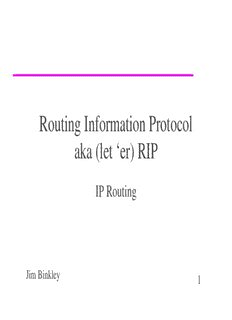
Routing Information Protocol aka (let ‘er) RIP PDF
Preview Routing Information Protocol aka (let ‘er) RIP
Routing Information Protocol aka (let ‘er) RIP IP Routing Jim Binkley 1 outline ◆ intro ◆ theory including convergence and bugs ◆ rip v1 protocol ◆ rip v2 protocol ◆ Cisco config example with default route redistribution ◆ conclusions Jim Binkley 2 protocols acc. to topology topology IETF ISO/OSI intra-link ARP ES-IS intra-domain RIP, RIP(2), IS-IS OSPF inter-domain EGP, BGP(4) IDRP, IDPR Jim Binkley 3 the Interior - RIP or OSPF Joe Bob Inc’s Network Map routers in out interior domain link Jim Binkley 4 bibliography ◆ RIPv1, RFC 1058, Charles Hedrick, 1988. – documented existing practice ◆ RIPv2, Gary Malkin, RFC 1388 – RIPv2, RIP speaks CIDR (netmasks included with destination) – RFC 2453 is update, 1389 MIB, 1721-1724 – MD5 authentication, 2082 ◆ Huitema, Routing in the Internet, 2nd Edition, 1999 Jim Binkley 5 history ◆ Bellman/Ford/Fulkerson and Distance/Vector idea, late 50’s, early 60’s ◆ Bellman, “Dynamic Programming”, Princeton University Press, 1957 ◆ Vector-Distance can mean IP Destination/Hop- Count (as with RIP) ◆ Distance in other protocols might mean something else – hello, TIME; BGP, A.S. path to destination Jim Binkley 6 Vector-Distance nodes and edges A V=“this way to B” D=“cost is N” B C D Jim Binkley 7 cont. ◆ BSD app based on XNS (Xerox) version, Netware RIP is similar too (surprise) – BSD 4.2 on VAX (1982 or so) ◆ done first and RFC 1058 (1988) later created ◆ in widespread use for at least two reasons widely available, came with that there Sun WS – # routed & is (mostly) all you need to do – ◆ BSD routed and Cornell gated support it (free) ◆ Cisco evolved into IGRP, and later EIGRP ◆ Appletalk - Routing Table Maint. Protocol (RTMP) Jim Binkley 8 RIP details ◆ messages carried in UDP datagrams, send/recv on port 520 ◆ broadcast every 30 seconds, routing table as pairs of (to net, hop count) e.g., v1 ip dst = 255.255.255.255 ◆ hop count, direct connect == 1, network one router away is 2 hops away ◆ new route with shorter hop count replaces older route ◆ on init, router requests route table from neighbors ◆ therefore two fundamental message types – request (done at boot. give me your routing table) – response (almost all messages are response) Jim Binkley 9 more RIP details ◆ when routing response received, routing table is updated (metrics aren’t typically displayed in netstat -rn unfortunately) ◆ route has timeout. 3 minutes, no new info, then mark with metric=16, one minute later delete (holddown so the fact that route is gone is propagated) ◆ infinity == 16, RIP can suffer count to infinity ◆ default route is route to 0.0.0.0 ◆ routers are “active”, hosts are “passive”, determined by whether or not system > 1 i/f (can set by hand) Jim Binkley 10
Description: